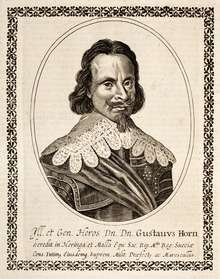Gustav Horn, Count of Pori
| Count Gustav Horn af Björneborg | |
|---|---|
 | |
| Born |
October 22, 1592 Örbyhus Castle, Uppland |
| Died | May 10, 1657 (aged 65) |
| Allegiance |
|
| Rank | Field Marshal |
| Battles/wars |
Thirty Years' War Battle of Breitenfeld Battle of Nördlingen Torstenson War |
Count Gustav Horn af Björneborg (October 22, 1592 – May 10, 1657) was a Swedish/Finnish soldier and politician. He was the youngest son of Field Marshal Carl Horn and Agneta von Dellwig, born while his father was imprisoned in Örbyhus Castle, after the defeat against the Russians.
He was born of the Finnish noble family Horn of Kankas, and was appointed member of the Royal Council in 1625, Field Marshal in 1628, Governor General of Livonia in 1652 and Lord High Constable since 1653. In the Thirty Years' War (1618–1648), he was instrumental as a commander in securing victory at the Battle of Breitenfeld, in 1631. He was High Councillor of the realm in 1625, elevated to the rank of field marshal in 1628, and sometimes commander-in-chief of Swedish forces in Germany during Thirty Years' War. After the war, he served as Governor-General of Livonia 1652, President of War department and Lord High Constable in 1653. In 1651, Queen Christina created him Count of Björneborg.
Education and Early Military Career
Young lord Gustav Horn studied extensively in European universities, and then took part in war against Russia. He studied military sciences under prince Maurice of Orange in the Netherlands.
As colonel, Gustav Horn took part in siege of Riga in 1621 and was seriously wounded. He led troops which conquered Tartu in Livonian Estonia. With count Jakob De la Gardie, he led defense of Livonia against Poland in late 1620s. Already at the age of 35, he was elevated to the rank of field marshal, by king Gustav II Adolf, also known as Gustavus Adolphus.
Command of Swedish Forces in the Thirty Years War

When the king decided to join the war in Germany (1630), he appointed Gustav Horn as his second in command. At the battle of Breitenfeld in 1631, Horn prevented the Imperial force under Tilly from flanking the main body of the Swedish army, after their Saxon allies had fled the field. After this Horn led troops in Upper (southern) Franconia and conquered, among others, Mergentheim, the town of the Teutonic Order, and the bishopric of Bamberg). He then went to Bavaria with the king. Horn was sent to lead troops in the Rhineland, where he occupied Koblenz and Trier, and continued to Swabia.
After the death of king Gustav II Adolf at Lützen in November 1632, field marshal Horn and general John Banér were appointed to the overall command of the Swedish forces in Germany. Gustav Horn's father-in-law, the Chancellor Oxenstierna, took the leadership of the civil government.
When Horn was ordered to combine his troops with those of Bernhard of Weimar, the two men found themselves unable to work together, and they were given separate commands.
After Wallenstein's murder in 1634, Horn took some areas in Swabia: in the spring of that year his troops unsuccessfully laid siege to the imperial city of Überlingen, which would have been a rich and valuable prize. In early September 1634 his forces, and those of Bernard of Saxony, were crushed at the battle of Nördlingen by combined Habsburg and Spanish forces. Horn was taken prisoner and held by Catholic army in Burghausen Castle until 1642. He was exchanged for three imperial generals.
Later career
Following his exchange, Horn was appointed Vice President of War department. During the war against Denmark in 1644, Horn led the attack on Skåne and conquered the whole province, except the towns of Malmö and Kristianstad. Malmö's siege lasted until the Treaty of Brömsebro brought the war to an end. The conquest of Skåne became known as "the Horn War."
In 1651 Horn received Pori as his county and the castle of Marienborg, which already belonged to him, was made into a barony. Horn then served as Governor-General in Livonia, and as Lord High Constable of the empire, becoming Lord President of the War Department.
When war against Poland broke out in 1655, Gustav Horn directed the defense of Sweden against possible Polish invasion.
Legacy
Gustav Horn was one of the most capable of Gustav II Adolf's military commanders, and also an able administrator. His particular skills were in arranging defences for several sorts of situations. He also maintained relatively strict discipline, so his troops did not plunder and pillage as much as others.
Family
In 1628 Horn married firstly Kristina Oxenstierna (1609 – 1631), daughter of Count and Chancellor Axel Oxenstierna. They had two children:
- Agneta Horn (1629 – 1672), his heiress, who married baron Lars Cruus of Gudhem, Lord of Harviala.
- Axel Horn (1630 – 1631).
In 1643 Horn married secondly Sigrid Bielke (1620 – 1679). They had nine children:
- Anna Katarina Horn (born and died 1644).
- Kristina Horn (born and died 1646).
- Ebba Sigrid Horn (born and died 1646), twin with Kristina.
- Helena Horn (1647 – 1648).
- Maria Eleonora Horn (1648 – 1652).
- Gustav Karl Horn (1650 – 1654).
- Evert Horn (1652 – 1654).
- Eva Horn (1653 – 1740), married Nils Bielke.
- Hedvig Lovisa Horn (1655 – 17??), married firstly Ture Karlsson Sparre and secondly Bernhard von Liewen.